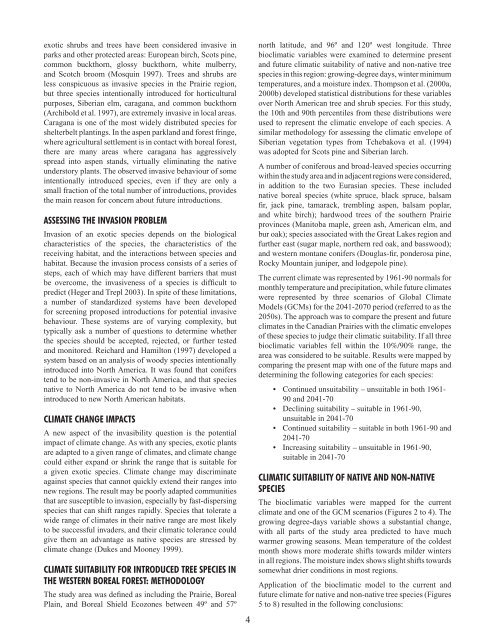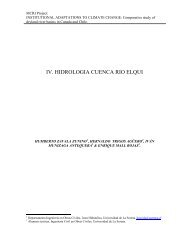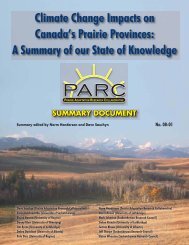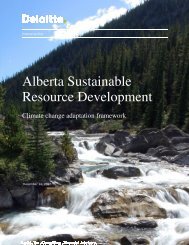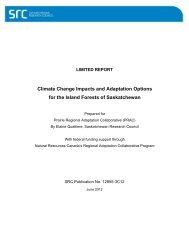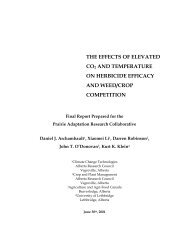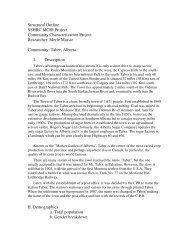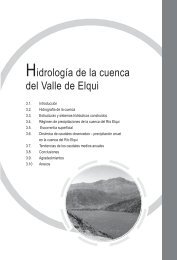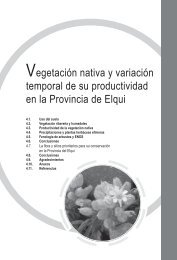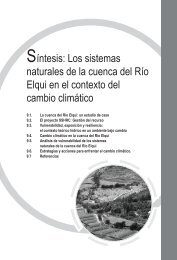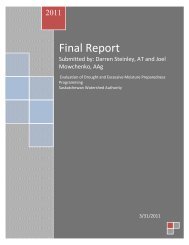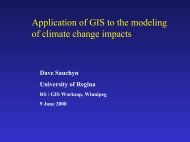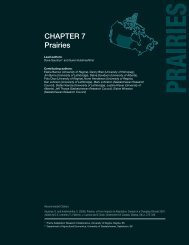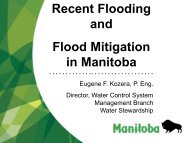Exotic Tree Species as an Adaptation Option to Climate Change in ...
Exotic Tree Species as an Adaptation Option to Climate Change in ...
Exotic Tree Species as an Adaptation Option to Climate Change in ...
You also want an ePaper? Increase the reach of your titles
YUMPU automatically turns print PDFs into web optimized ePapers that Google loves.
exotic shrubs <strong>an</strong>d trees have been considered <strong>in</strong>v<strong>as</strong>ive <strong>in</strong><br />
parks <strong>an</strong>d other protected are<strong>as</strong>: Europe<strong>an</strong> birch, Scots p<strong>in</strong>e,<br />
common buckthorn, glossy buckthorn, white mulberry,<br />
<strong>an</strong>d Scotch broom (Mosqu<strong>in</strong> 1997). <strong>Tree</strong>s <strong>an</strong>d shrubs are<br />
less conspicuous <strong>as</strong> <strong>in</strong>v<strong>as</strong>ive species <strong>in</strong> the Prairie region,<br />
but three species <strong>in</strong>tentionally <strong>in</strong>troduced for horticultural<br />
purposes, Siberi<strong>an</strong> elm, carag<strong>an</strong>a, <strong>an</strong>d common buckthorn<br />
(Archibold et al. 1997), are extremely <strong>in</strong>v<strong>as</strong>ive <strong>in</strong> local are<strong>as</strong>.<br />
Carag<strong>an</strong>a is one of the most widely distributed species for<br />
shelterbelt pl<strong>an</strong>t<strong>in</strong>gs. In the <strong>as</strong>pen parkl<strong>an</strong>d <strong>an</strong>d forest fr<strong>in</strong>ge,<br />
where agricultural settlement is <strong>in</strong> contact with boreal forest,<br />
there are m<strong>an</strong>y are<strong>as</strong> where carag<strong>an</strong>a h<strong>as</strong> aggressively<br />
spread <strong>in</strong><strong>to</strong> <strong>as</strong>pen st<strong>an</strong>ds, virtually elim<strong>in</strong>at<strong>in</strong>g the native<br />
unders<strong>to</strong>ry pl<strong>an</strong>ts. The observed <strong>in</strong>v<strong>as</strong>ive behaviour of some<br />
<strong>in</strong>tentionally <strong>in</strong>troduced species, even if they are only a<br />
small fraction of the <strong>to</strong>tal number of <strong>in</strong>troductions, provides<br />
the ma<strong>in</strong> re<strong>as</strong>on for concern about future <strong>in</strong>troductions.<br />
Assess<strong>in</strong>g the Inv<strong>as</strong>ion Problem<br />
Inv<strong>as</strong>ion of <strong>an</strong> exotic species depends on the biological<br />
characteristics of the species, the characteristics of the<br />
receiv<strong>in</strong>g habitat, <strong>an</strong>d the <strong>in</strong>teractions between species <strong>an</strong>d<br />
habitat. Because the <strong>in</strong>v<strong>as</strong>ion process consists of a series of<br />
steps, each of which may have different barriers that must<br />
be overcome, the <strong>in</strong>v<strong>as</strong>iveness of a species is difficult <strong>to</strong><br />
predict (Heger <strong>an</strong>d Trepl 2003). In spite of these limitations,<br />
a number of st<strong>an</strong>dardized systems have been developed<br />
for screen<strong>in</strong>g proposed <strong>in</strong>troductions for potential <strong>in</strong>v<strong>as</strong>ive<br />
behaviour. These systems are of vary<strong>in</strong>g complexity, but<br />
typically <strong>as</strong>k a number of questions <strong>to</strong> determ<strong>in</strong>e whether<br />
the species should be accepted, rejected, or further tested<br />
<strong>an</strong>d moni<strong>to</strong>red. Reichard <strong>an</strong>d Hamil<strong>to</strong>n (1997) developed a<br />
system b<strong>as</strong>ed on <strong>an</strong> <strong>an</strong>alysis of woody species <strong>in</strong>tentionally<br />
<strong>in</strong>troduced <strong>in</strong><strong>to</strong> North America. It w<strong>as</strong> found that conifers<br />
tend <strong>to</strong> be non-<strong>in</strong>v<strong>as</strong>ive <strong>in</strong> North America, <strong>an</strong>d that species<br />
native <strong>to</strong> North America do not tend <strong>to</strong> be <strong>in</strong>v<strong>as</strong>ive when<br />
<strong>in</strong>troduced <strong>to</strong> new North Americ<strong>an</strong> habitats.<br />
<strong>Climate</strong> Ch<strong>an</strong>ge Impacts<br />
A new <strong>as</strong>pect of the <strong>in</strong>v<strong>as</strong>ibility question is the potential<br />
impact of climate ch<strong>an</strong>ge. As with <strong>an</strong>y species, exotic pl<strong>an</strong>ts<br />
are adapted <strong>to</strong> a given r<strong>an</strong>ge of climates, <strong>an</strong>d climate ch<strong>an</strong>ge<br />
could either exp<strong>an</strong>d or shr<strong>in</strong>k the r<strong>an</strong>ge that is suitable for<br />
a given exotic species. <strong>Climate</strong> ch<strong>an</strong>ge may discrim<strong>in</strong>ate<br />
aga<strong>in</strong>st species that c<strong>an</strong>not quickly extend their r<strong>an</strong>ges <strong>in</strong><strong>to</strong><br />
new regions. The result may be poorly adapted communities<br />
that are susceptible <strong>to</strong> <strong>in</strong>v<strong>as</strong>ion, especially by f<strong>as</strong>t-dispers<strong>in</strong>g<br />
species that c<strong>an</strong> shift r<strong>an</strong>ges rapidly. <strong>Species</strong> that <strong>to</strong>lerate a<br />
wide r<strong>an</strong>ge of climates <strong>in</strong> their native r<strong>an</strong>ge are most likely<br />
<strong>to</strong> be successful <strong>in</strong>vaders, <strong>an</strong>d their climatic <strong>to</strong>ler<strong>an</strong>ce could<br />
give them <strong>an</strong> adv<strong>an</strong>tage <strong>as</strong> native species are stressed by<br />
climate ch<strong>an</strong>ge (Dukes <strong>an</strong>d Mooney 1999).<br />
<strong>Climate</strong> Suitability for Introduced <strong>Tree</strong> <strong>Species</strong> <strong>in</strong><br />
the Western Boreal Forest: Methodology<br />
The study area w<strong>as</strong> def<strong>in</strong>ed <strong>as</strong> <strong>in</strong>clud<strong>in</strong>g the Prairie, Boreal<br />
Pla<strong>in</strong>, <strong>an</strong>d Boreal Shield Ecozones between 49º <strong>an</strong>d 57º<br />
4<br />
north latitude, <strong>an</strong>d 96º <strong>an</strong>d 120º west longitude. Three<br />
bioclimatic variables were exam<strong>in</strong>ed <strong>to</strong> determ<strong>in</strong>e present<br />
<strong>an</strong>d future climatic suitability of native <strong>an</strong>d non-native tree<br />
species <strong>in</strong> this region: grow<strong>in</strong>g-degree days, w<strong>in</strong>ter m<strong>in</strong>imum<br />
temperatures, <strong>an</strong>d a moisture <strong>in</strong>dex. Thompson et al. (2000a,<br />
2000b) developed statistical distributions for these variables<br />
over North Americ<strong>an</strong> tree <strong>an</strong>d shrub species. For this study,<br />
the 10th <strong>an</strong>d 90th percentiles from these distributions were<br />
used <strong>to</strong> represent the climatic envelope of each species. A<br />
similar methodology for <strong>as</strong>sess<strong>in</strong>g the climatic envelope of<br />
Siberi<strong>an</strong> vegetation types from Tchebakova et al. (1994)<br />
w<strong>as</strong> adopted for Scots p<strong>in</strong>e <strong>an</strong>d Siberi<strong>an</strong> larch.<br />
A number of coniferous <strong>an</strong>d broad-leaved species occurr<strong>in</strong>g<br />
with<strong>in</strong> the study area <strong>an</strong>d <strong>in</strong> adjacent regions were considered,<br />
<strong>in</strong> addition <strong>to</strong> the two Eur<strong>as</strong>i<strong>an</strong> species. These <strong>in</strong>cluded<br />
native boreal species (white spruce, black spruce, balsam<br />
fir, jack p<strong>in</strong>e, tamarack, trembl<strong>in</strong>g <strong>as</strong>pen, balsam poplar,<br />
<strong>an</strong>d white birch); hardwood trees of the southern Prairie<br />
prov<strong>in</strong>ces (M<strong>an</strong>i<strong>to</strong>ba maple, green <strong>as</strong>h, Americ<strong>an</strong> elm, <strong>an</strong>d<br />
bur oak); species <strong>as</strong>sociated with the Great Lakes region <strong>an</strong>d<br />
further e<strong>as</strong>t (sugar maple, northern red oak, <strong>an</strong>d b<strong>as</strong>swood);<br />
<strong>an</strong>d western mont<strong>an</strong>e conifers (Dougl<strong>as</strong>-fir, ponderosa p<strong>in</strong>e,<br />
Rocky Mounta<strong>in</strong> juniper, <strong>an</strong>d lodgepole p<strong>in</strong>e).<br />
The current climate w<strong>as</strong> represented by 1961-90 normals for<br />
monthly temperature <strong>an</strong>d precipitation, while future climates<br />
were represented by three scenarios of Global <strong>Climate</strong><br />
Models (GCMs) for the 2041-2070 period (referred <strong>to</strong> <strong>as</strong> the<br />
2050s). The approach w<strong>as</strong> <strong>to</strong> compare the present <strong>an</strong>d future<br />
climates <strong>in</strong> the C<strong>an</strong>adi<strong>an</strong> Prairies with the climatic envelopes<br />
of these species <strong>to</strong> judge their climatic suitability. If all three<br />
bioclimatic variables fell with<strong>in</strong> the 10%/90% r<strong>an</strong>ge, the<br />
area w<strong>as</strong> considered <strong>to</strong> be suitable. Results were mapped by<br />
compar<strong>in</strong>g the present map with one of the future maps <strong>an</strong>d<br />
determ<strong>in</strong><strong>in</strong>g the follow<strong>in</strong>g categories for each species:<br />
• Cont<strong>in</strong>ued unsuitability – unsuitable <strong>in</strong> both 1961-<br />
90 <strong>an</strong>d 2041-70<br />
• Decl<strong>in</strong><strong>in</strong>g suitability – suitable <strong>in</strong> 1961-90,<br />
unsuitable <strong>in</strong> 2041-70<br />
• Cont<strong>in</strong>ued suitability – suitable <strong>in</strong> both 1961-90 <strong>an</strong>d<br />
2041-70<br />
• Incre<strong>as</strong><strong>in</strong>g suitability – unsuitable <strong>in</strong> 1961-90,<br />
suitable <strong>in</strong> 2041-70<br />
Climatic Suitability of Native <strong>an</strong>d Non-Native<br />
<strong>Species</strong><br />
The bioclimatic variables were mapped for the current<br />
climate <strong>an</strong>d one of the GCM scenarios (Figures 2 <strong>to</strong> 4). The<br />
grow<strong>in</strong>g degree-days variable shows a subst<strong>an</strong>tial ch<strong>an</strong>ge,<br />
with all parts of the study area predicted <strong>to</strong> have much<br />
warmer grow<strong>in</strong>g se<strong>as</strong>ons. Me<strong>an</strong> temperature of the coldest<br />
month shows more moderate shifts <strong>to</strong>wards milder w<strong>in</strong>ters<br />
<strong>in</strong> all regions. The moisture <strong>in</strong>dex shows slight shifts <strong>to</strong>wards<br />
somewhat drier conditions <strong>in</strong> most regions.<br />
Application of the bioclimatic model <strong>to</strong> the current <strong>an</strong>d<br />
future climate for native <strong>an</strong>d non-native tree species (Figures<br />
5 <strong>to</strong> 8) resulted <strong>in</strong> the follow<strong>in</strong>g conclusions:


